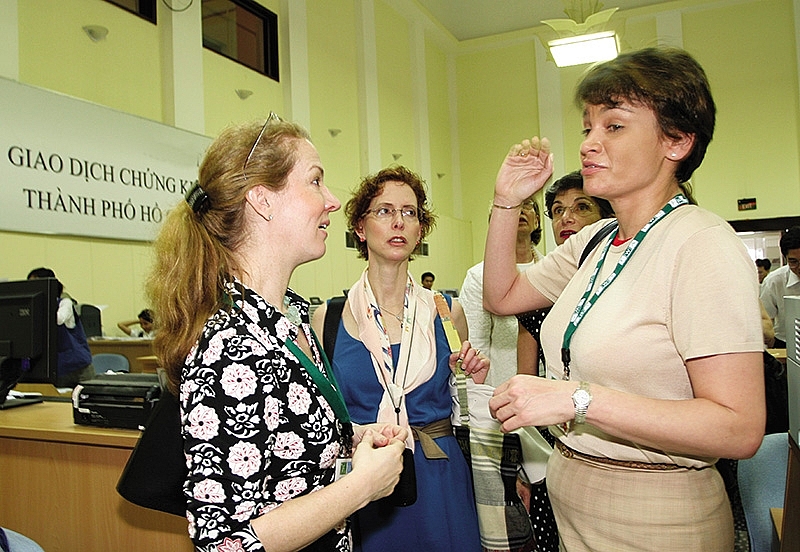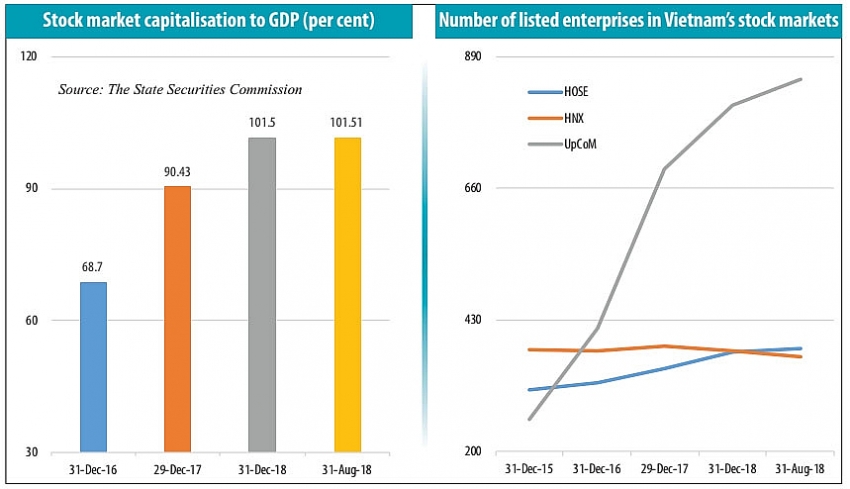Hindrances preventing FIEs from listing on stock market
 |
| Clearing up issues in regards to ownership percentage is just one area which will improve the fortunes of foreign-invested enterprises, Photo: Le Toan |
Vietnam’s stock market began its formation in 2000. In the early period, market capitalisation was low, at about 1 per cent of GDP, but after nearly 20 years, it grew to 100 per cent of GDP, as of the end of August.
 |
| Nguyen Hung Quang, managing partner at NHQuang & Associates |
From the very start when only two enterprises were listed on the Ho Chi Minh City Stock Exchange (HSX), now there are over 1,000 enterprises listed on the HSX, the Hanoi Stock Exchange, and on the the Unlisted Public Companies Market.
Along with the development of the stock market, Vietnam enables foreign-invested enterprises (FIEs) to invest in the form of joint-stock companies (previously only limited liability companies). By 2003, the Vietnamese government allowed the pilot for a number of FIEs to be listed on the stock market under the government’s Decree No.38/2003/ND-CP issued in 2003 on transforming a number of FIEs to operate in the form of joint-stock company, and under the prime minister’s Decision No.238/2005/QD-TTg enacted in 2005 on the percentage of participation of foreign parties in Vietnam’s stock market.
The number of listed FIEs, however, is still very limited for a number of reasons, the two main reasons being regulations and the performance of state agencies.
Regulatory barriers
Regulations on conditions and procedures for FIEs to be listed on the Vietnamese stock market have been unclear since 2003. Several enterprises did prepare dossiers for listing but still have to wait for specific instructions from competent agencies. Moreover, FIEs that wanted to be listed on the stock market had to transform into joint-stock companies as former laws only allowed FIEs to invest in the form of limited liability companies. Such transformation took them much time and effort. Under the provisions of the Law on Investment, the percentage of foreign ownership in listed companies must be under the provisions of the Law on Securities. Before an FIE applies for listing on a stock exchange, its percentage of foreign ownership must not exceed the maximum percentage stipulated by law.
Decree No.60/2015/ND-CP released in 2015 which amended and supplemented Decree No.58/2012/ND-CP promulgated in 2012 guiding the Law on Securities, provides the following:
• Where a listed company is subject to an international treaty in which Vietnam is a member, the maximum percentage of foreign ownership in such company shall be defined under such treaties;
• Where a listed company conducts business activities which have a limitation on the foreign ownership provided by the Law on Investment or other relevant laws, the maximum percentage of foreign ownership shall be defined under such law;
• Where a listed company conducts business in a conditional business line, and the Law on Investment and other relevant laws do not prescribe a maximum percentage of ownership, the maximum percentage of foreign ownership shall be 49 per cent;
• If a listed company conducts business in more than one business lines, the maximum percentage of foreign ownership shall be the smallest of the stipulated percentages;
• If a listed company is not subject to any of the cases mentioned above, the percentage of foreign ownership can be up to 100 per cent without any limitation.
Despite the guidelines, FIEs still face difficulties in identifying their business lines in the list of conditional lines applicable to international investors in the normative legal documents while Vietnamese authorities have not had a comprehensive list of conditional business lines for foreign investors pouring money into Vietnamese firms.
The unclear criteria and conditions of ownership percentage are the most difficult part for FIEs in identifying the divestment amount to meet listing conditions. This is also a risk when foreign investors of an FIE become such enterprise’s shareholders with the listing as condition precedent. The press has also mentioned several cases where FIEs that could not be listed on the stock market had encountered questions from their shareholders.
 |
Possible changes in the near future?
There are concerns from some state agencies in the country about foreign investors in FIEs who could take advantage of the ability to freely trade stocks at listed companies to divest.
It may be a remarkable risk for both the Vietnamese stock market and investors.
After 30 years of opening up to foreign direct investment, Vietnam had a more open approach to attracting investment.
Resolution No.50/NQ-TW dated August 20 mentions “the foreign-invested economic sector” in a broader sense, instead of emphasising just the form of “foreign direct investment”.
The extension can be understood in the way that Vietnam is calling for more foreign indirect investment capital and improving the ability of investment co-operation between domestic and overseas investors in various forms.
The facilitation for FIEs to be listed on Vietnam’s stock market will facilitate not only foreign investors but also the spread of technology and knowledge between the foreign-invested and domestic sectors.
Simultaneously, this also contributes to ensuring an equal treatment among investors under the new -generation international investment agreements which Vietnam participates in.
What the stars mean:
★ Poor ★ ★ Promising ★★★ Good ★★★★ Very good ★★★★★ Exceptional
Related Contents
Latest News
More News
- Tax sector wraps up 2025 and sets priorities for next year (December 25, 2025 | 14:00)
- A tipping point for digital and hybrid wealth management in Vietnam (December 23, 2025 | 13:33)
- $250 million deal targets women-owned SMEs, sustainable agriculture (December 22, 2025 | 17:40)
- Stock market posts resilient 2025 performance (December 19, 2025 | 18:17)
- Citi Vietnam receives 2025 AmCham CSR recognition (December 19, 2025 | 16:35)
- As global green supply chain reshapes, will Vietnam be left behind? (December 19, 2025 | 08:00)
- Banks gear up for massive capital increases (December 18, 2025 | 17:04)
- Securing capital and efficiency for Vietnam’s 2026-2030 growth ambitions (December 17, 2025 | 10:00)
- Energy sector in need of blended finance mechanisms (December 17, 2025 | 09:00)
- Vietnam still has room to mobilise capital for sustainable growth (December 17, 2025 | 08:57)

 Tag:
Tag:




















 Mobile Version
Mobile Version